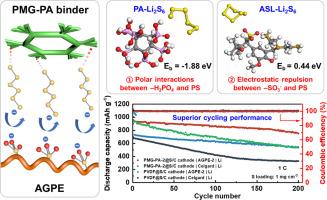当前位置:
X-MOL 学术
›
Energy Storage Mater.
›
论文详情
Our official English website, www.x-mol.net, welcomes your
feedback! (Note: you will need to create a separate account there.)
Ion-selective gel polymer electrolyte and cathode binder derived from a shared polyether to synergistically mitigate polysulfides shuttling in lithium sulfur batteries
Energy Storage Materials ( IF 18.9 ) Pub Date : 2024-10-30 , DOI: 10.1016/j.ensm.2024.103870 Mingjia Lu, Kai Chen, Zhenyu Jia, Jianguo Ren, Peng He, Shengyuan Yang, Roohollah Bagherzadeh, Feili Lai, Yue-E Miao, Tianxi Liu
Energy Storage Materials ( IF 18.9 ) Pub Date : 2024-10-30 , DOI: 10.1016/j.ensm.2024.103870 Mingjia Lu, Kai Chen, Zhenyu Jia, Jianguo Ren, Peng He, Shengyuan Yang, Roohollah Bagherzadeh, Feili Lai, Yue-E Miao, Tianxi Liu

|
As one kind of the most promising candidates for next-generation batteries, lithium-sulfur (Li-S) batteries with high theoretical energy density are still faced with the severe shuttle effect of polysulfides (PS) and safety issues caused by the flammable liquid electrolytes. To overcome the above challenges, an enhanced ion-selective strategy is proposed by collaboratively crosslinking a polyether containing epoxy groups with negatively charged aminated sodium lignosulfonate (ASL) and polar phytic acid (PA), respectively, to prepare a PS-repelling gel polymer electrolyte (AGPE) and a PS-anchoring cathode binder (PMG-PA) for Li-S batteries. The synergistically suppressed shuttle effect of PS makes the Li-S battery deliver a high capacity of 749.7 mAh g-1 over 200 cycles at 1 C with a super low capacity decay of 0.11 % per cycle, compared to the poor cycling performance (329.1 mAh g-1 over 200 cycles with a capacity decay of 0.26 % per cycle) of the conventional liquid electrolyte-based battery using polyvinylidene difluoride as the cathode binder. Furthermore, AGPE confines the liquid electrolyte within the polymer network, while ASL quenches free radicals during potential ignition events, thereby significantly enhancing the battery safety during operation. Therefore, the co-design strategy of ion-selective AGPE and PMG-PA cathode binder derived from a shared polyether offers a new way to mitigate polysulfides shuttling for safe and reliable Li-S batteries.
中文翻译:

离子选择性凝胶聚合物电解质和源自共享聚醚的阴极粘合剂,可协同缓解锂硫电池中的多硫化物穿梭
作为下一代电池最有前途的候选电池之一,具有高理论能量密度的锂硫 (Li-S) 电池仍面临多硫化物 (PS) 的严重穿梭效应和易燃液体电解质带来的安全问题。为了克服上述挑战,该文提出了一种增强的离子选择性策略,将含有环氧基团的聚醚分别与带负电荷的胺化木质素磺酸钠 (ASL) 和极性植酸 (PA) 协同交联,制备了用于锂硫电池的 PS 排斥凝胶聚合物电解质 (AGPE) 和 PS 锚定阴极粘合剂 (PMG-PA)。PS 的协同抑制穿梭效应使锂硫电池在 1 C 下 200 次循环可提供 749.7 mAh g-1 的高容量,与使用聚偏二氟乙烯作为阴极粘合剂的传统液体电解质基电池的不良循环性能(200 次循环 329.1 mAh g-1,每次循环容量衰减 0.26%)相比,每循环 0.11% 的超低容量衰减。此外,AGPE 将液体电解质限制在聚合物网络内,而 ASL 在潜在的点火事件中淬灭自由基,从而显着提高电池在运行过程中的安全性。因此,离子选择性 AGPE 和源自共享聚醚的 PMG-PA 阴极粘合剂的协同设计策略提供了一种缓解多硫化物穿梭的新方法,以实现安全可靠的 Li-S 电池。
更新日期:2024-10-30
中文翻译:

离子选择性凝胶聚合物电解质和源自共享聚醚的阴极粘合剂,可协同缓解锂硫电池中的多硫化物穿梭
作为下一代电池最有前途的候选电池之一,具有高理论能量密度的锂硫 (Li-S) 电池仍面临多硫化物 (PS) 的严重穿梭效应和易燃液体电解质带来的安全问题。为了克服上述挑战,该文提出了一种增强的离子选择性策略,将含有环氧基团的聚醚分别与带负电荷的胺化木质素磺酸钠 (ASL) 和极性植酸 (PA) 协同交联,制备了用于锂硫电池的 PS 排斥凝胶聚合物电解质 (AGPE) 和 PS 锚定阴极粘合剂 (PMG-PA)。PS 的协同抑制穿梭效应使锂硫电池在 1 C 下 200 次循环可提供 749.7 mAh g-1 的高容量,与使用聚偏二氟乙烯作为阴极粘合剂的传统液体电解质基电池的不良循环性能(200 次循环 329.1 mAh g-1,每次循环容量衰减 0.26%)相比,每循环 0.11% 的超低容量衰减。此外,AGPE 将液体电解质限制在聚合物网络内,而 ASL 在潜在的点火事件中淬灭自由基,从而显着提高电池在运行过程中的安全性。因此,离子选择性 AGPE 和源自共享聚醚的 PMG-PA 阴极粘合剂的协同设计策略提供了一种缓解多硫化物穿梭的新方法,以实现安全可靠的 Li-S 电池。


















































 京公网安备 11010802027423号
京公网安备 11010802027423号